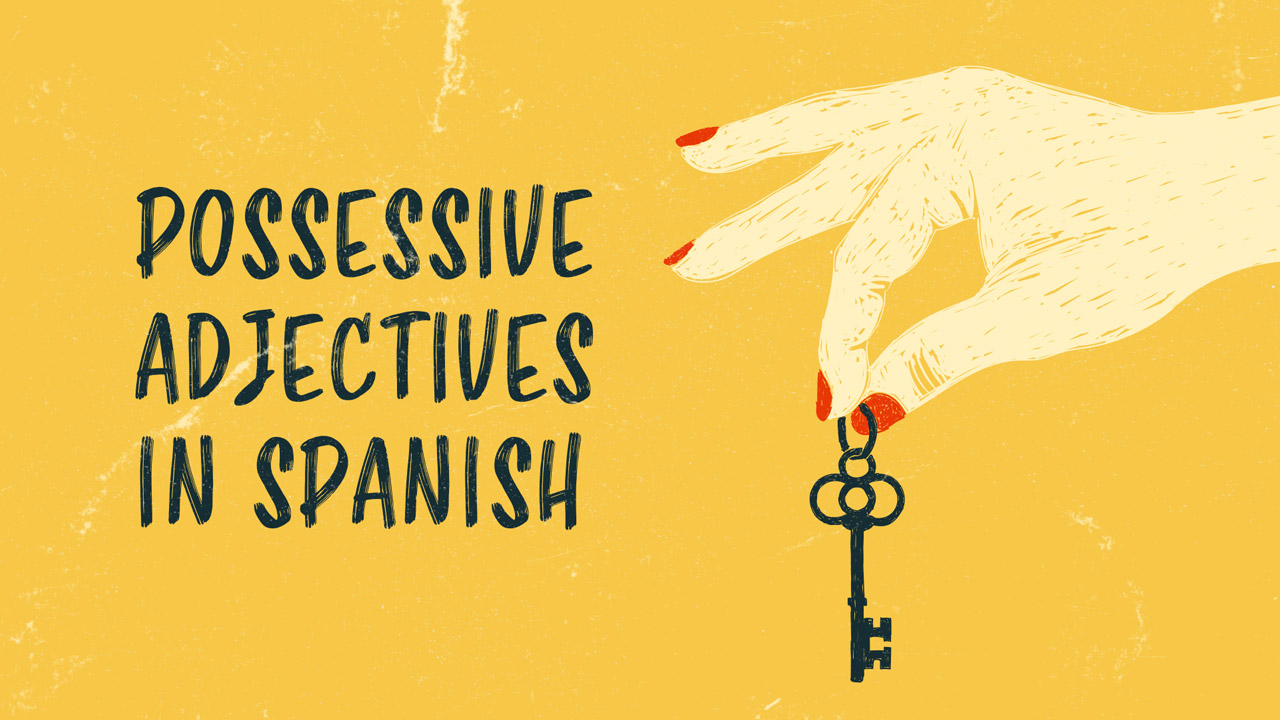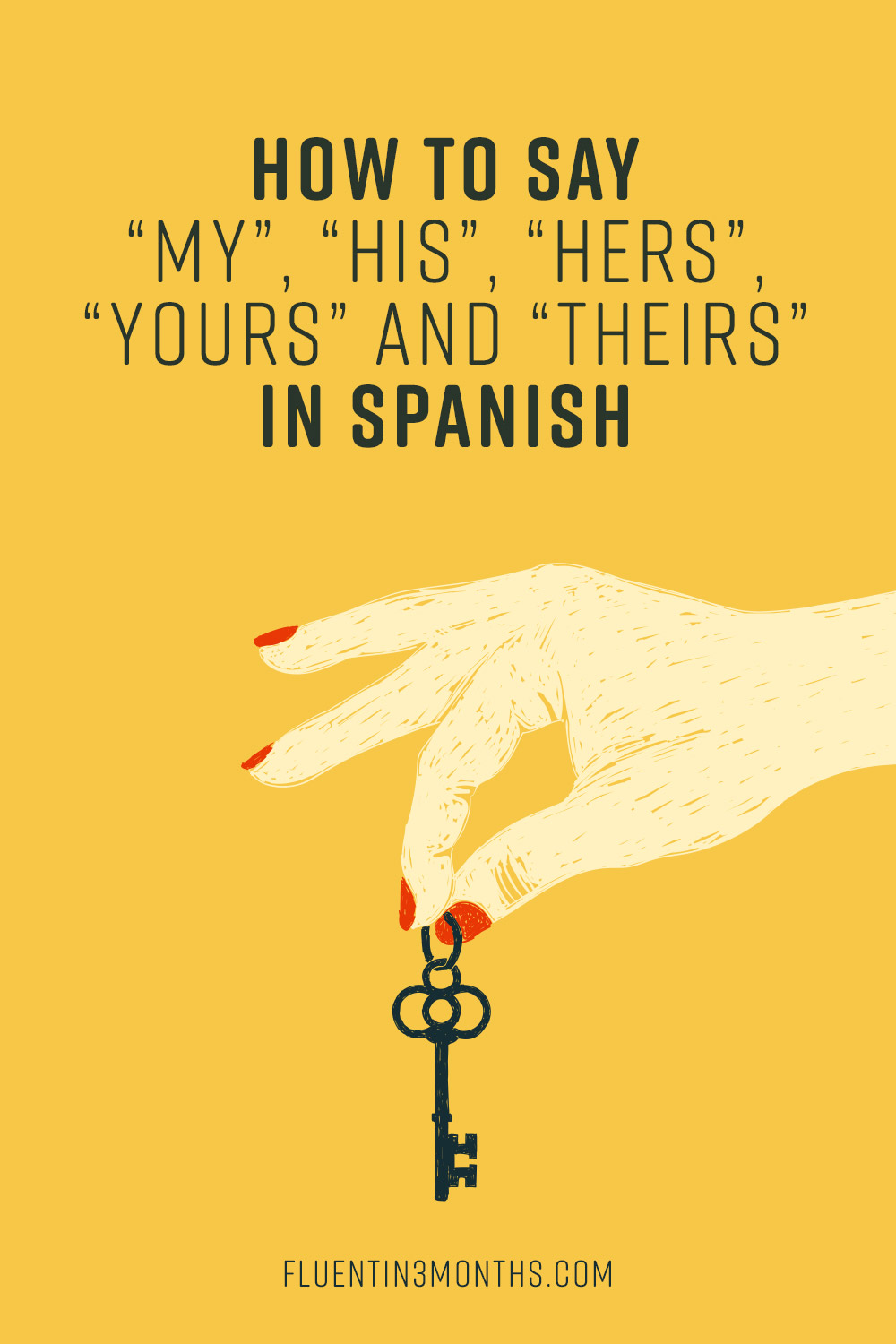How to Use Possessive Adjectives in Spanish
Possessive adjectives in Spanish are words like “my” (mi) and “his” (suya). They show that an object belongs to somebody.
Possessive adjectives work a little differently in Spanish compared to English. I’ve put together this guide so you can understand exactly how they work.
In this complete guide to mastering Spanish possessive adjectives, you’ll learn:
Table of contents
- Spanish Possessive Adjectives: What Are They?
- How Many Possessive Adjectives Are There in Spanish?
- Short-Form Possessive Adjectives in Spanish
- Long-Form Possessive Adjectives in Spanish
- Besides Spanish Possessive Adjectives: Other Ways to Indicate Possession in Spanish
- How to Learn the Possessive Adjectives in Spanish: Practice! (Plus a Free Spanish Adjectives Worksheet)
- Some Example Spanish Sentences With Possessive Adjectives
- You’re On Your Way to Mastering All the Possessive Adjectives in Spanish
There is a lot to learn, so let’s get started!
Spanish Possessive Adjectives: What Are They?
What are possessive adjectives in Spanish?
An adjective is a word that describes a noun. Words like rojo (“red”) and delgado (“thin”) are adjectives.
As I mentioned earlier, the role of a possessive adjective in Spanish is to describe ownership. Possessive adjectives specify who or what owns or possesses something.
Here are some examples:
- Traje mi libro – “I brought my book.”
- La hermana suya no vino – “His sister didn’t come.”
There are two types of possessive adjectives in Spanish: short-form and long-form. Short-form possessive adjectives go before the noun they describe. Long-form possessive adjectives go after the noun.
I’ll explain more about each type in a moment.
How Many Possessive Adjectives Are There in Spanish?
There are only eight possessive adjectives in Spanish.
Sounds strange? In the chart above it might look like there are more, but if you look closely, you’ll notice that su/s and suyo/a/os/as appear twice. What’s more, nuestro/a/os/as and vuestro/a/os/as count both as short-form and long-form possessive adjectives.
Not only that, but once you learn the stems, you only need to apply the standard gender and number changes when they’re needed.
“Stems?” You might think. “Benny, you’ve lost me!” Let me take a step back a moment. By stems, I mean the masculine singular possessive adjectives because they are the simplest form.
So yes, you only have eight possessive adjectives to learn in Spanish!
Short-Form Possessive Adjectives in Spanish
Here is the first important bit of information: short-form possessive adjectives in Spanish are the shortest Spanish possessive adjectives. They’re also the most common, so you might have already come across them and perhaps even used them.
In Spanish, they are known as adjetivos posesivos átonos (“atonic possessive adjectives”) or adjetivos posesivos débiles (“weak possessive adjectives”). In English, we also call them “unstressed possessive adjectives”.
Here’s a simple chart to learn short-form Spanish possessive adjectives:
| Singular | Plural | |||
| Masculine | Feminine | Masculine | Feminine | |
| my | mi | mi | mis | mis |
| your (with tú and vos) | tu | tu | tus | tus |
| his, her, your (with usted) | su | su | sus | sus |
| our | nuestro | nuestra | nuestros | nuestras |
| your (with vosotros and vosotras) | vuestro | vuestra | vuestros | vuestras |
| their, your (with ustedes) | su | su | sus | sus |
As you can see, short-form possessive adjectives follow the rule of agreement for adjectives in Spanish.
The first rule is about numbers. If the described noun is plural, so is the adjective. Look at mi and mis. Or su and sus.
Spanish has the same rule for adjectives with gender. However, with short-form possessive adjectives, the gender agreement only applies to nuestro/a/os/as and vuestro/a/os/as.
¡Ojo! (“Be careful!”) Spanish adjectives agree in gender and number with the word they describe. With possessive adjectives, this means that the adjective changes according to what is possessed, and not whoever or whatever possesses it.
Examples:
- Dame tus cuadernos – “Give me your notebooks.” (“Your” agrees with “notebooks”.)
- Traje nuestra bicicleta – “I brought our bicycle.” (“Our” agrees with “bicycle”.)
- Marta vio vuestros primos – “Marta saw your cousins.” (“Your” agrees with “cousins”.)
Long-Form Possessive Adjectives in Spanish
If you’ve already studied Spanish for some time, you might have come across sentences using long-form possessive adjectives.
In Spanish, they’re known as adjetivos posesivos tónicos (“tonic possessive adjectives”) or adjetivos posesivos fuertes (“strong possessive adjectives”). They aren’t as popular as the short-form possessive adjectives. In English, we also call them “stressed possessive adjectives”.
Here’s a simple chart to learn Spanish long-form possessive adjectives:
| Singular | Plural | |||
| masc. | fem. | masc. | fem. | |
| of mine | mío | mía | míos | mías |
| of yours (tú, vos) | tuyo | tuya | tuyos | tuyas |
| of his/of hers/of yours (usted) | suyo | suya | suyos | suyas |
| of ours | nuestro | nuestra | nuestros | nuestras |
| of yours (vosotros/as) | vuestro | vuestra | vuestros | vuestras |
| of theirs/of yours (ustedes) | suyo | suya | suyos | suyas |
As you’ve learnt earlier in the post, long-form possessive adjectives in Spanish go after the noun they describe.
Examples:
- Son primos nuestros. – “They’re cousins of ours.” Or “They’re our cousins.”
- La amiga suya está llegando – “The friend of hers is coming.” Or “Her friend is coming.”
- Es problema tuyo. – “It’s a problem of yours.” Or “It’s your problem.”
They are known as “stressed” because they shift the attention from the noun they describe to themselves. In other words, when stressed possessive adjectives are used in Spanish, what belongs isn’t important in the sentence. To whom it belongs to is highlighted, instead.
Besides Spanish Possessive Adjectives: Other Ways to Indicate Possession in Spanish
There are two other ways to indicate possession in Spanish: using the preposition de and using possessive pronouns.
The preposition de is the Spanish equivalent of the genitive Saxon, the English apostrophe “s”.
Example: La bicicleta de Marta. (“Marta’s bicycle.”)
Possessive pronouns in Spanish look exactly like long-form possessive adjectives. Take a look at this chart:
| Possessive pronouns | Long-form possessive adjectives | |||||
| Singular | Plural | |||||
| Masculine | Feminine | Masculine | Feminine | |||
| mine | mío | mía | míos | mías | of mine | mío/a/as/os |
| yours (with tú and vos) | tuyo | tuya | tuyos | tuyas | of yours | tuyo/a/os/as |
| his, hers, yours (with usted) | suyo | suya | suyos | suyas | of his/hers/yours | suyo/a/os/as |
| ours | nuestro | nuestra | nuestros | nuestras | of ours | nuestro/a/os/as |
| yours (with vosotros and vosotras) | vuestro | vuestra | vuestros | vuestras | of yours | vuestro/a/os/as |
| theirs, yours (with ustedes) | suyo | suya | suyos | suyas | of theirs/yours | suyo/a/os/as |
So how can you tell the difference between the two?
First of all, they have different grammatical roles. Just as an adjective describes a word, a pronoun replaces a word or a phrase in a sentence. This word or phrase has usually already been mentioned or is implied.
And secondly, the possessive pronouns follow a definite article. “The” is the English definite article. In Spanish, “the” translates to el, la, los, las.
Examples:
- Si olvidaste tu lápiz, usa el nuestro. – “If you forgot your pencil, use ours.”
- No entiendo cuál es la casa de Marta. La mía es la azul. – “I don't understand which is Marta’s house. Mine is the blue one.”
How to Learn the Possessive Adjectives in Spanish: Practice! (Plus a Free Spanish Adjectives Worksheet)
Here’s the secret: when it comes to language learning, the only real magic is… practice. In all the years I spent working my way to fluency in over ten languages, I have never found the single best way to improve. As I often say, mistakes make the best masters.
Here’s how to learn possessive adjectives in Spanish:
Create a list of possessive adjectives in Spanish. Practice by building sentences that include possessive adjectives, both short-form and long-form.
After a bit of time, you’ll be confident in your ability to choose the right adjectives and correctly spell them. This is when you should start practicing out loud.
To do this, I recommend practicing with native speakers. The best place to find someone to have a conversation is Preply (our review is here). You could also practice with an AI tutor on Teacher AI.
You can also quiz yourself or use this worksheet about possessive adjectives in Spanish to improve your skills.
Some Example Spanish Sentences With Possessive Adjectives
Here are some Spanish sentences with possessive adjectives:
- Me gusta mi vecindario. → short-form – “I like my neighborhood.”
- El libro mío está dañado. → long-form – “My book is damaged.”
- Aquí están tus amigas. → short-form – “Here are your friends.”
- Las manzanas tuyas son muy buenas.→ long-form – “Your apples are very good.”
- Señor Pablo, su almuerzo está listo. → short-form – “Mr. Pablo, your lunch is ready.”
- Los hijos suyos estudian muy bien. → long-form – “Your children study very well.”
- Amelia no sabe si sus padres vendrán.” → short-form – “Amelia doesn’t know if her parents will come.”
- Rompí nuestra bicicleta. → short-form – “I broke our bicycle.”
- El coche nuestro es azul. → long-form – “Our car is blue.”
- Nuestros primos no se fueron. → short-form – “Our cousins didn’t go.”
- Vuestras camisas están manchadas. → short-form – “Your shirts are stained.”
- El cuaderno vuestro lo tiene Marcos. → long-form – “Marcos has your notebook.”
- Sus perros son muy tiernos. → short-form – “Their dogs are really cute.”
You’re On Your Way to Mastering All the Possessive Adjectives in Spanish
That’s all you need to know to master possessive adjectives in Spanish.
For more help with speaking Spanish, you can learn about Spanish reflexive verbs. I also recommend learning the 101 core Spanish words.
If you’d like to learn how to speak Spanish quickly, then check out the Fluent in 3 Months Challenge, where you’ll have a 15-minute conversation in Spanish after just 90 days of learning.
¡Nos vemos en otra aventura! (“See you on another adventure!”)




Social